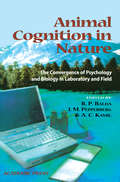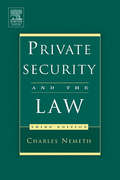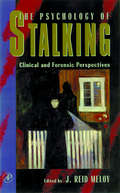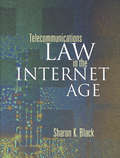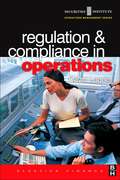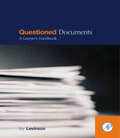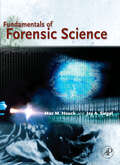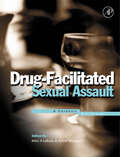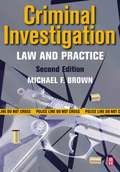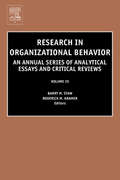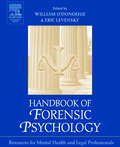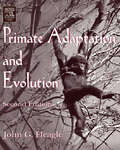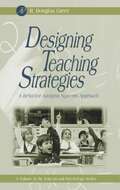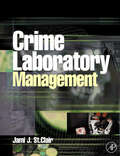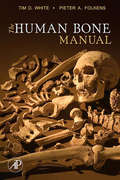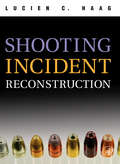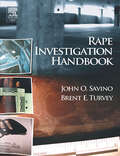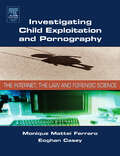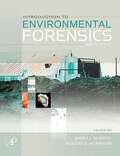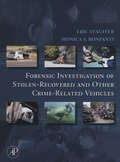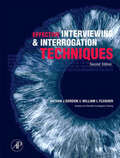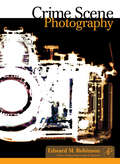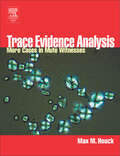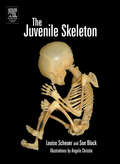- Table View
- List View
Animal Cognition in Nature: The Convergence of Psychology and Biology in Laboratory and Field
by Russell P. Balda Irene M. Pepperberg A. C. KamilIn this book, the editors bring together results from studies on all kinds of animals to show how thinking on many behaviors as truly cognitive processes can help us to understand the biology involved. Taking ideas and observations from the while range of research into animal behavior leads to unexpected and stimulating ideas. A space is created where the work of field ecologists, evolutionary ecologists and experimental psychologists can interact and contribute to a greater understanding of complex animal behavior, and to the development of a new and coherent field of study.
Private Security and the Law
by Charles NemethPrivate Security and the Law, Third Edition is a textbook analysis of significant practices in the security industry that relate to law, regulation, licensure and constitutional dilemmas according to case and statutory authority. It is a treatise on the state of the law that governs the security industry and its operatives. The book fills the void that an increasing number of institutions are seeking as they expand their security programs in response to the growing demand for security education. This book delivers up to date information on the legal requirements witnessed by most security firms. It also explores the liability problems common to security operations, including negligence and tortious liability, civil actions commonly litigated, and strategies to avoid troublesome causes of action that effect business efficiency. From another angle, the work examines the constitutional and due process dimensions of private security work and affords the reader a look at how case law applies certain remedies to wronged parties. Recent cases, and the trends sure to follow, are highlighted throughout the text. Finally, the text is filled with checklists, data and other useful information that aids the security practitioner in applying theory to practice. This book will appeal to students in security and criminal justice programs; private security consultants; corporate security managers; and lawyers.* Up to date case law analysis provides cutting edge legal treatment of evolving standards* Complicated material is presented in a down-to-earth, readable style, perfect for the student of security or security professional* Over 200 tables and illustrations allow the reader speedy access to precise data
The Psychology of Stalking: Clinical and Forensic Perspectives
by J. Reid MeloyThe Psychology of Stalking is the first scholarly book on stalking ever published. Virtually every serious writer and researcher in this area of criminal psychopathology has contributed a chapter. These chapters explore stalking from social, psychiatric, psychological and behavioral perspectives. New thinking and data are presented on threats, pursuit characteristics, psychiatric diagnoses, offender-victim typologies, cyberstalking, false victimization syndrome, erotomania, stalking and domestic violence, the stalking of public figures, and many other aspects of stalking, as well as legal issues. This landmark text is of interest to both professionals and other thoughtful individuals who recognize the serious nature of this ominous social behavior.First scholarly book on stalking ever publishedContributions from virtually all major researchers in fieldDiscussion of what to do when being stalkedUses examples from recent publicized cases
Telecommunications Law in the Internet Age (ISSN)
by Sharon K. BlackFor companies in and around the telecommunications field, the past few years have been a time of extraordinary change-technologically and legally. The enacting of the Telecommunications Act of 1996 and the development of international trade agreements have fundamentally changed the environment in which your business operates, creating risks, responsibilities, and opportunities that were not there before.Until now, you'd have had a hard time finding a serious business book that offered any more than a cursory glance at this transformed world. But at last there's a resource you can depend on for in-depth analysis and sound advice. Written in easy-to-understand language, Telecommunications Law in the Internet Age systematically examines the complex interrelationships of new laws, new technologies, and new business practices, and equips you with the practical understanding you need to run your enterprise optimally within today's legal boundaries.* Offers authoritative coverage from a lawyer and telecommunications authority who has been working in the field for over three decades.* Examines telecommunications law in the U.S., at both the federal and state level.* Presents an unparalleled source of information on international trade regulations and their effects on the industry.* Covers the modern telecommunications issues with which most companies are grappling: wireless communication, e-commerce, satellite systems, privacy and encryption, Internet taxation, export controls, intellectual property, spamming, pornography, Internet telephony, extranets, and more.* Provides guidelines for preventing inadvertent violations of telecommunications law.* Offers guidance on fending off legal and illegal attacks by hackers, competitors, and foreign governments.* Helps you do more than understand and obey the law: helps you thrive within it.
Regulation and Compliance in Operations (Securities Institute Operations Management)
by David Loader'Regulation and Compliance in Operations' looks at how regulation affects the operations function by focusing on regulatory issues and drivers. As regulatory demands ever increasing, it is important for operations teams to be aware of the important regulatory issues which exist globally. Like any other part of an organization in the financial services industry, operations has rules and regulations to comply with. Although many view regulation as being about rooting out rogue traders and controlling speculators, its role is much more profound than this, and without it many more 'scandals' would undoubtedly occur. The problem for the regulator is that unless total oversight of every transaction, account, business and individual can be made, there will always be rogue traders or more recent examples like Enron and World.Com. As such intense oversight is not practical, the regulator can only do so much, with most of the responsibility resting with the firms and organizations themselves.For operations teams their role in protecting the firm stems from their ability to manage critical processes like reconciliation, asset position agreements and the nostro accounts efficiently and effectively. Regulators need the help and support of the businesses to have a 'business-friendly environment'. When some abuse the trust placed in them and the regulatory environment, a 'scandal' or worse occurs, with the result that the majority are penalized as regulators react to criticism and apply more onerous regulations.It is often the operations teams that bear most, or at least some, of the repercussions of greater regulatory oversight of the business. It is therefore vitally important for operations teams to have a firm understanding of the regulatory issues and drivers. This book will help you gain that understanding, as well as looking at the important regulatory issues in the various global markets in which your business operates.* This book completes the popular Securities Institute Operations Management Series* Explains the role of regulation and compliance in UK, US and global financial markets* Provides a valuable perspective from the operations department viewpoint without getting caught up in the minute details of regulations
Questioned Documents: A Lawyer's Handbook
by Jay LevinsonQuestioned documents are any documents that may be used as evidence in a trial, ranging from handwritten notes to counterfeit currency to contracts. This concise new handbook is designed specifically to aid lawyers involved in cases that involve questioned documents (QD) evidence. It explains the basics of document examination and helps litigators improve the way they present document evidence and question witnesses. It also provides references to professional literature and other legal sources, making it easy to find further information when needed.Questioned Documents: A Lawyer's Handbook provides analyses applied to many types of investigations and types of documents. It outlines the techniques for determining authenticity, age, ink and paper sources, handwriting identification, equipment used, forgeries, alterations, erasures, and more. In addition to helping the attorneys who mush present the QD evidence and ask the questions, this handbook is also an important resource for the expert witnesses who will be asked those questions at trial.Key Features* Explains the basics of document examination and shows how they apply to a variety of cases* Helps litigators improve the way they present document evidence and interrogate witnesses* Saves hours in pre-trial interviews by providing lawyers with the a thorough knowledge of the topic* Presents case examples from the US, UK, The Netherlands, Germany, Nepal, Israel, Jordan, Russia, Romania and more* Includes actual questions that can be asked of expert witnesses* Provides an extensive list of references and research suggestions* Helps document examiners learn about the application of their expertise in the courtroom, and what to expect when questioned by attorneys
Protecting Your Ideas: The Inventor's Guide to Patents
by Joy L. BryantIntellectual property law is currently exploding, as demonstrated by the growth of technology transfer offices in universities. More and more scientists, companies, and institutions are rushing to secure intellectual property rights for their ideas and inventions. This process frustrates many people; patent laws are constantly changing, and most books about them are either overly technical or boring. Protecting Your Ideas: The Inventor's Guide to Patents is a succinct, straightforward guide to the system. This guide presents the steps involved in obtaining patent protection for inventions. It is easy to read and brimming with essential information and advice compounded from FAQs posed by the author's academic and industrial clientele. The text includes tips, warnings, and examples that guide the reader through the invention process so patent rights are not jeopardized. Checklists and other helpful information are provided to assist the inventor preparing to enter the patent process. The book includes valuable resource information and business guidance to protect the inventor from consumer fraud that is sometimes associated with the patent process. Protecting and Idea is a must read for every engineer, scientist, or amateur inventor.Simple, easy-to-read format demystifies the patent processNumerous example patents help to illustrate the issues involvedProvides an overview of the types of intellectual property protectionIncorporates up-to-date information about U.S. patent lawsAdvises inventors about the do's and don'ts of patentingIncludes useful resources for helping inventors safeguard their ideas
Fundamentals of Forensic Science
by Max M. Houck Jay A. SiegelFundamentals of Forensic Science offers a complete look at the core topics of forensic science. It represents the most realistic view of the field by including areas that, while central to criminal investigation, fall outside the typical definition of criminalistics. These areas include pathology, entomology, anthropology, and other areas of scientific study unique to forensic textbooks. Organized by the timeline of a real case, the text begins with an introduction and history of forensic science. It then covers the methods of analysis used in most forensic examinations, addressing the biological, chemical and physical elements relevant to the field, and concluding with an examination of how forensic science intersects with law. Feature boxes throughout the text contain online resource listings, historical events in forensic science, practical issues in laboratory analysis, and topics for further reading or interest. This book is recommended for students in forensic science and professionals in the various forensic disciplines – fire, chemistry, crime scene, trace evidence, law enforcement personnel, lawyers, and defense attorneys.- Vivid, full-color illustrations that diagram key concepts and depict evidence encountered in the field- Straightforward unit organization that includes key terms, numerous feature boxes emphasizing resources on the World Wide Web, historical events in forensic science, practical issues in laboratory analysis, and topics for further reading- Effective pedagogy -including end-of-chapter questions- paired with a clear writing style makes this an invaluable resource for professors and students of forensic science
Drug-Facilitated Sexual Assault: A Forensic Handbook
by Marc A. LeBeau Ashraf MozayaniDrug-Facilitated Sexual Assault educates readers on the ways in which drugs are used as weapons in committing sexual assaults and how to successfully investigate these crimes. It looks at the history of these crimes over the years, and includes an in-depth discussion of the drugs and drug classes in use today. It describes the effects of these drugs on the victims, the process for reporting these crimes, details on the type of person who uses drugs to sexually assault an individual, and obstacles to investigating the suspect. The authors show the proper techniques in collecting and analyzing evidence; ways to overcome some of the unique difficulties encountered in these types of investigations; and how to work with other professionals to prosecute these cases successfully. The concluding appendixes are valuable samples of the necessary forms needed to complete these investigations. This book is ideal for anyone involved in investigating these crimes, including forensic scientists, law enforcement officers, lawyers, toxicologists, and medical professionals.* Ideal for everyone involved in the investigation of these crimes, including forensic scientists, police officers, lawyers, toxicologists and medical professionals
Criminal Investigation: Law and Practice
by Michael F. BrownThis textbook provides students and law enforcement officers with the fundamentals of the criminal investigation process, from arrival on the scene to trial procedures. Written in a clear and simple style, Criminal Investigation: Law and Practice surpasses traditional texts by presenting a unique combination of legal, technical, and procedural aspects of the criminal investigation. The hands-on approach taken by the author helps to increase the learning experience.Criminal Investigation: Law and Practice, Second Edition, has been written to provide future law enforcement officers with a basic understanding of the investigative process. It merges two areas that are crucial to the successful completion of an investigation: the law, both criminal and procedural, and criminal investigative techniques. It is writen to provide the student investigator with the information needed to complete and investigation that can result in a successful prosecution.- comprehensive coverage of the criminal investigation, from arrival on the scene to trial procedures-unique combination of legal, technical, and procedural aspects of criminal investigation-many updated cases, many personally experienced by the author.
Research in Organizational Behavior (ISSN #Volume 25)
by Roderick M. Kramer Barry StawThis volume celebrates the first quarter century of publishing Research in Organizational Behavior. From its inception, Research in Organizational Behavior has striven to provide important theoretical integrations of major literatures in the organizational sciences, as well as timely examination and provocative analyses of pressing organizational issues and problems. In keeping with this tradition, the current volume offers an eclectic mix of scholarly articles that address a variety of important questions in organizational theory and do so from a diverse range of disciplinary perspectives and theoretical orientations. A number of the chapters also directly engage contemporary events and dilemmas of considerable importance.
Handbook of Forensic Psychology: Resource for Mental Health and Legal Professionals
by William O'Donohue Eric R. LevenskyForensic psychology has mushroomed into a diverse and increasingly complex field that is equal parts law and psychology. Psychologists act as expert witnesses in legal cases - sometimes without knowing much about the laws involved, and legal professionals rely on the assessment of psychologists sometimes without knowing much about how such assessments are made. The purpose of this handbook is to provide professionals with current, practical, and empirically based information to guide their work in forensic settings, or to better their understanding of the issues and debates in forensic psychology.Divided into four sections, the Handbook of Forensic Psychology covers basic issues, assessment, mental disorders and forensic psychology, and special topics. The basic issue chapters present a primer on law for the psychologist, a primer on psychology for attorneys, an overview of ethical issues relevant to forensic psychology, and a chapter on forensic report writing. The assessment section discusses factors and measures relevant for assessing a variety of behaviors, propensities, and capabilities, including dangerousness, violence, suicide, competency, substance abuse, PTSD and neuropsychological evaluations, as well as discussing interviewing children and child custody evaluations. Additional chapters discuss eyewitness testimony, recovered memory, polygraphs, sexual harassment, juror selection, and issues of ethnicity in forensic psychology.
Primate Adaptation and Evolution
by John G. FleagleJohn Fleagle has improved on his 1988 text by reconceptualizing chapters and by bringing new findings in functional and evolutionary approaches to bear on his synthesis of comparative primate data. The Second Edition provides a foundation upon which students can develop an understanding of our primate heritage. It features up-to-date information gained through academic training, laboratory experience and field research. This beautifully illustrated volume provides a comprehensive introductory text explaining the many aspects of primate biology and human evolution.Key Features* Provides up-to-date information about many aspects of primate biology and evolution* Contains a completely new chapter on primate communities* Presents totally revised chapters on primate origins, early anthropoids, and fossil platyrrhines* Includes an updated glossary, new illustrations, and a revised Classification of Order Primates* Succeeds as the best introductory text on primate evolution because it synthesizes and allows access to primary literature
Designing Teaching Strategies: An Applied Behavior Analysis Systems Approach (ISSN)
by R. Douglas GreerThe US Dept. of Education, in conjunction with the US Dept. of Health and Human Services, recently unveiled a $50 million effort to expand research on early childhood cognitive development. A key issue identified requiring more information and research was the education and professional development of educators. Along these lines, Doug Greer has prepared a book discussing how best to teach, how to design functional curricula, and how to support teachers in using state-of-the-art science instruction materials. The book provides important information both to trainers of future teachers, current teachers, and to supervisors and policy makers in education. To trainers there is information on how to motivate, mentor, and instruct in-service teachers to use the best scientifically based teaching strategies and tactics. To in-service teachers, there is information on how to provide individualized instruction in classrooms with multiple learning and behavior problems, school interventions to help prevent vandalism and truancy, and how curricula and instruction can be designed to teach functional repetoirs rather than inert ideas. To policy makers and supervisors, the book discusses how to determine the effectiveness of curricular innitiatives toward meeting mandated standards in national assessments.Doug Greer was recently awarded the Fred S. Keller Award for Distinguished Contributions to Education by APA for the research and application of the material covered in this book. School programs incorporating the material used in this book have produced 4-7 times more learning outcomes for students than control and baseline educational programs (see www.cabas.com)The book provides research-based and field-tested procedures for:* Teaching students of all ability levels ranging from preschool to secondary school* How to teach special education students in the context of a regular classroom* Best practices for all teachers to teach more effectively* Means of monitoring and motivating teachers' practices* A comprehensive and system-wide science of teaching—post modern-postmodern!* Tested procedures that result in four to seven times more learning for allstudents* Tested procedures for supervisors to use with teachers that result insignificant student learning* Tested procedures for providing the highest accountability* A systems approach for schooling problems that provide solutions ratherthan blame* Parent approved and parent requested educational practices* Means for psychologists to work with teachers and students to solvebehavior and learning problems* A comprehensive systems science of schooling* An advanced and sophisticated science of pedagogy and curriculum design* Students who are not being served with traditional education can meet orexceed the performance of their more fortunate peers,* Supervisors can mentor teachers and therapists to provide state of thescience instruction* Parent education can create a professional setting for parents, educators,and therapists to work together in the best interests of the student,* Teachers and supervisors who measure as they teach produce significantlybetter outcomes for students,* Systemic solutions to instructional and behavioral problems involvingteachers, parents, supervisors provide means to pursue problems to theirsolution,* A science of teaching, as opposed to an art of teaching, can provide aneducational system that treats the students and the parents as the clients.
Crime Laboratory Management
by Jami St. ClairCrime Laboratory Management is the first book to address the unique operational, administrative, and political issues involved in managing a forensic laboratory. It guides managers and supervisors through essential tasks ranging from hiring and training of staff to quality control, facilities management, and public relations. Author Jami St. Clair has more than 20 years experience in forensic science and served as President of the American Society of Crime Lab Directors in 1998-1999. She and her colleagues have designed this book to be useful for supervisors at every level. With its combination of classic management theories and practical information, this unique resource will help managers ensure that their laboratories operate efficiently and survive the intense scrutiny of today's criminal justice system. It will also help students and professional with an interest in forensic science and crime laboratory operation to better understand the functions of labs and the critical role they play in handling and analyzing evidence.* Shows how to handle a wide variety of administrative and operational issues in forensic laboratories * Provides new and experienced managers with practical information from qualified experts * Outlines standards and procedures to help ensure quality results from laboratory analyses
The Human Bone Manual
by Tim D. White Pieter A. FolkensBuilding on the success of their previous book, White and Folkens' The Human Bone Manual is intended for use outside the laboratory and classroom, by professional forensic scientists, anthropologists and researchers. The compact volume includes all the key information needed for identification purposes, including hundreds of photographs designed to show a maximum amount of anatomical information.Features more than 500 color photographs and illustrations in a portable format; most in 1:1 ratioProvides multiple views of every bone in the human bodyIncludes tips on identifying any human bone or toothIncorporates up-to-date references for further study
Shooting Incident Reconstruction
by Lucien C. HaagShooting Incident Reconstruction is based on the authors' numerous years of conducting courses and seminars on the subject of shooting incident reconstruction. It seeks to thoroughly address matters from simple to complex in order to provide the reader with an explanation of the factors surrounding ballistics, trajectory, and shooting scenes. The ultimate objectives of this unique book are to assist investigators, crime scene analysts, pathologists, ballistics experts, and lawyers to understand the terminology, science, and factors involved in reconstructing shooting incident events to solve forensic cases. The book covers a full range of related topics, including the range from which a firearm was discharged; the sequence of shots in a multiple discharge shooting incident; the position of a firearm at the moment of discharge; the position of a victim at the moment of impact; the probable flight path of a projectile; the manner by which a firearm was discharged, and much more. It contains over 100 diagrams and photographs, many in full-color, that support and illustrate key concepts.- Written by one of the most well-respected shooting scene and ballistics experts in the world- Contains over 100 diagrams and photographs, many in full-color, that support and illustrate key concepts- Case studies illustrate real-world application of technical concepts
Rape Investigation Handbook
by Brent E. TurveyThe Rape Investigation Handbook is the first practical and hands-on manual written by sex crime investigators and forensic scientists, providing students with first-hand insight into the work of these professionals. It is the only comprehensive reference available on the investigation of sexual assault and rape. It includes extensive accounts of perpetrators, victims, and other rape case evidence for identification of incidents of rape. The key feature of this text is a thorough overview of the investigative and forensic processes related to sex crime investigation. It takes the reader through investigative and forensic processes in a logical sequence, showing how investigations of rape and sexual assault can and should be conducted from start to finish. This book is designed to be accessible, in terms of language and approach, to the student in the classroom learning about the subject for the first time. It is an excellent training manual for sex crime investigators as well as an excellent textbook for any hands-on university course on the subject of sex crime investigation. This book would also serve as a useful supplement for any investigative course involving violent crime or death investigation.* The only comprehensive reference available on the investigation of sexual assault and rape, a crime 10 times more prevalent than murder* Authored by qualified investigators and forensic professionals with more than twenty years of collective experience working cases, preparing them for court, and offering testimony* Written in a clear, practical style, ideal for professionals in forensic nursing, law enforcement, the legal community, and the investigative community
Investigating Child Exploitation and Pornography: The Internet, Law and Forensic Science
by Eoghan Casey Monique FerraroInvestigating Child Exploitation and Pornography provides the historical, legal, technical, and social background for the laws prohibiting child exploitation, in particular, child pornography. It offers a history of child exploitation cases and studies, outlining the roles of technology in this type of crime and the evidence they can contain, and documenting new research performed by the authors. It details how successful undercover Internet operations are conducted, how the associated evidence is collected, and how to use the evidence to locate and apprehend the offender. The heart of this work is a legal section, detailing all of the legal issues that arise in Internet child exploitation cases. A forensic examination section presents evidentiary issues from a technical perspective and describes how to conduct a forensic examination of digital evidence gathered in the investigative and probative stages of a child exploitation case. The book will become an indispensable resource for those involved in the investigation, prosecution, and study of computer-assisted child sexual exploitation.The first comprehensive title in this subject areaUses real cases and examples of criminal behavior and the means to detect itProvides guidelines for developing a Field Manual and a Checklist to supplement the investigation and legal processEstablishes a reliable system and legal, procedural-backed protocol by which to conduct an online sexual investigation and collect evidence
Introduction to Environmental Forensics
by Brian L. Murphy Robert D. MorrisonIntroduction to Environmental Forensics helps readers unravel the complexities of environmental pollution cases. It outlines techniques for identifying the source of a contaminant release, when the release occurred, and the extent of human exposure. Written by leading experts in environmental investigations, the text provides detailed information on chemical "fingerprinting" techniques applicable to ground water, soils, sediments, and air, plus an in-depth look at petroleum hydrocarbons. It gives the environmental scientist, engineer, and legal specialist a complete toolbox for conducting forensic investigations. It demonstrates the range of scientific analyses that are available to answer questions of environmental liability and support a legal argument, and provides several examples and case studies to illustrate how these methods are applied. This is a textbook that would prove useful to a range of disciplines, including environmental scientists involved in water and air pollution, contaminated land and geographical information systems; and archaeologists, hydrochemists and geochemists interested in dating sources of pollution. Co-edited by one of the experts from the Civil Action case in Woburn, MA Provides essential information about identifying environmental contaminants responsible for millions of deaths per year Contains the latest information and coverage of issues crucial to both forensics investigators and environmental scientists
Forensic Investigation of Stolen-Recovered and Other Crime-Related Vehicles
by Eric Stauffer Monica BonfantiForensic Investigation of Stolen-Recovered and Other Crime-Related Vehicles provides unique and detailed insights into the investigations of one of the most common crime scenes in the world. In addition to a thorough treatment of auto theft, the book covers vehicles involved in other forms of crime—dealing extensively with the various procedures and dynamics of evidence as it might be left in any crime scene. An impressive collection of expert contributors covers a wide variety of subjects, including chapters on vehicle identification, examination of burned vehicles, vehicles recovered from under water, vehicles involved in terrorism, vehicle tracking, alarms, anti-theft systems, steering columns, and ignition locks. The book also covers such topics as victim and witness interviews, public and private auto theft investigations, detection of trace evidence and chemical traces, vehicle search techniques, analysis of automotive fluids, vehicle registration, document examination, and vehicle crime mapping. It is the ultimate reference guide for any auto theft investigator, crime scene technician, criminalist, police investigator, criminologist, or insurance adjuster.Extensively researched and exceptionally well-written by internationally-recognized experts in auto theft investigation and forensic scienceAll the principles explained in the text are well-illustrated and demonstrated with more than 450 black and white and about 100 full-color illustrations, many directly from real casesServes as both a valuable reference guide to the professional and an effective teaching tool for the forensic science student
Effective Interviewing and Interrogation Techniques
by Nathan J. Gordon William L. FleisherEffective Interviewing and Interrogation Techniques, Second Edition, is completely revised and updated so as to cover all the information a student needs to know to obtain answers from a witness, a victim, or a suspect and how to interpret these answers with the utmost accuracy. Building on the previous edition’s ground-breaking search for truth in criminal and non-criminal investigations, this book contains five new chapters which include coverage of false confessions, interviewing the mentally challenged, and the ethics of interrogation in a post 9/11 world. This new edition includes highly illustrated chapters with topics ranging from the psycho-physiological basis of the forensic assessment to preparation for the interview/interrogation; question formulation; projective analysis of unwitting verbal clues; interviewing children and the mentally challenged; and pre-employment interviewing. Also included are several model worksheets and documents, case studies, and complete instructions for using the authors’ Integrated Interrogation Technique, a 10-point, highly successful approach to obtaining confessions that can stand up in court. The book concludes with an insightful look at the future of truth verification. This book will be of benefit to attorneys, coroners, detectives, educators, forensic psychophysiologists (lie detection), human resource professionals, intelligence professionals, and investigators as well as journalists/authors, jurists, medical professionals, psychological professionals, researchers, and students.- Expanded coverage of Statement Analysis, including actual statements from real cases.- New photos to aid in assessing nonverbal behavior.- Added section on assessment of written statements.
Crime Scene Photography
by Edward M. RobinsonCrime Scene Photography is a book wrought from years of experience, with material carefully selected for ease of use and effectiveness in training, and field tested by the author in his role as a Forensic Services Supervisor for the Baltimore County Police Department.While there are many books on non-forensic photography, none of them adequately adapt standard image-taking to crime scene photography. The forensic photographer, or more specifically the crime scene photographer, must know how to create an acceptable image that is capable of withstanding challenges in court. This book blends the practical functions of crime scene processing with theories of photography to guide the reader in acquiring the skills, knowledge and ability to render reliable evidence.Required reading by the IAI Crime Scene Certification Board for all levels of certificationContains over 500 photographsCovers the concepts and principles of photography as well as the "how to" of creating a final productIncludes end-of-chapter exercises
Trace Evidence Analysis: More Cases in Forensic Microscopy and Mute Witnesses
by Max M. HouckTrace Evidence Analysis continues and builds upon the tradition of its successful companion title Mute Witnesses (2000). The book contains nine entirely new cases, each self-contained in its own chapter, covering everything from homicides to accident reconstruction. It includes contributions from some of the premier forensic scientists in the field who provide detailed accounts of the process of collection, classification, and analysis of microscopic evidence to draw definitive conclusions that solved actual cases. The book discusses the role of evidence in solving cases and explores the legal and ethical responsibility of the forensic scientist. It examines real-world application of scientific methods and analytic principles, including evidence gathering, instrumentation, sampling methods, analysis, and interpretation; and features over 160 full-color figures that illustrate the relevant case evidence. This book is a recommended resource for forensic microscopists and trace evidence analysts, crime laboratories, crime scene technicians, criminal investigators, forensic science professionals and students, and the legal community.Contains contributions from some of the premier forensic scientists in the fieldDiscusses the role of evidence in solving cases and explores the legal and ethical responsibility of the forensic scientistExplores real-world application of scientific methods and analytic principles including evidence gathering, instrumentation, sampling methods, analysis, and interpretationIncludes over 160 full-color figures that illustrate the relevant case evidence
The Juvenile Skeleton
by Louise Scheuer Sue BlackThe identification of even the smallest human fetal bone can be vital to the success of a criminal investigation or to the identification of the deceased. This book examines every bone in the human body from its earliest embryological stage through to maturity and is profusely illustrated with superb bone drawings at every stage of development. The ability to identify every component of the developing skeleton is of core relevance not only to the forensic profession but also to clinicians, skeletal biologists and physical anthropologists.Identifies every component of the developing skeletonProvides detailed analysis of juvenile skeletal remains and the development of bone as a tissueSummarizes key morphological stages in the development of every bone
